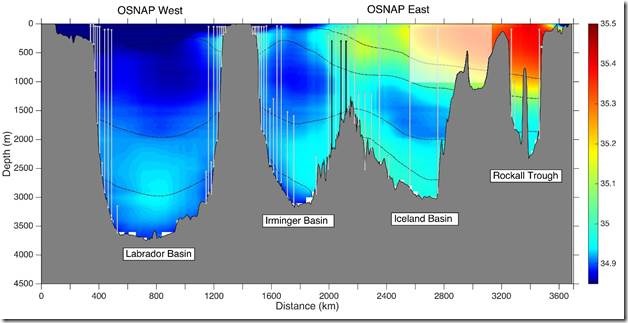
There seems to be a fairly constant stream of papers published that shine a new light on one part of the climate or global circulatory systems. Without fail, and without irony, they suggest that this new discovery will enable better climate models and a better understanding of the role of CO2.
Why bother? The science was settled years ago – just ask Stuff, they’ll tell you that there is nothing to be gained from further debate.
This time it is the meridional overturning circulation in the North Atlantic that has been ‘properly’ studied and thrown up surprises.
Quote.The overturning of water in the North Atlantic depends on meridional overturning circulation (MOC) wherein warm surface waters in the tropical Atlantic move to higher latitudes losing heat and moisture to the atmosphere along the way. In the North Atlantic and Arctic this water, now saline and cold, sinks to produce north Atlantic Deep water (NADW). It completes its circulation by flowing back toward the tropics or into other ocean basins at depth, and then subsequently upwelling through a variety of mechanisms. The time scale of this overturning is 600 years or so.End quote.
The MOC transports large amounts of heat from the tropics toward the poles, and is thought to be responsible for the relatively mild climate of northern Europe. The heat being transferred from the ocean surface back into the atmosphere at high latitudes is as large as 50W/m2, which is roughly equivalent to solar radiation reaching the surface at high latitudes during winter months.
In order to evaluate models of ocean overturning oceanographers have relied upon hydrographic research cruises. But the time increment between successive cruises is often long, and infrequent sampling cannot measure long term trends reliably nor gauge current ocean dynamics.
To get a better handle on MOC behavior an array of sensors to continuously monitor temperature, salinity, and velocity measurements known as the Overturning in the Subpolar North Atlantic Program (OSNAP) was recently deployed across the region at multiple depths. [The diagram above] shows sensor moorings in relation to the various ocean basins of the North Atlantic. [They found] from the first 21 months of operation […] a rather large variability of overturning in the eastern North Atlantic between Greenland and Scotland that reaches +/-10 Sverdrup (Sv=one million cubic meters per second) monthly, and amounts to one-half the MOC’s total annual transport. Researchers had thought that such variability was only possible on time scales of decades or longer.
The original experimental design for sensor placement in OSNAP was predicated on much smaller variability of a few Sv per month. The report does not address what impact this surprising level of transport variability has on validity of the experiment design; but the surprisingly large variations in flow challenge expectations derived from climate models regarding the relative amount of overturning between the Labrador Sea and the gateway to the Arctic between Greenland and Scotland.
As one oceanographer put it, the process of deep water formation and sinking of the MOC is more complex than people believed, and these results should prepare people to modify their ideas about how the oceans work. This improved data should not only help test and improve climate models, but also produce more realistic estimates of CO2 uptake and storage.
Settled science bobbing around like a cork in the ocean and that is only after 21 months of study. What will they learn after five years?





